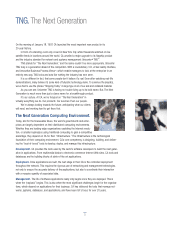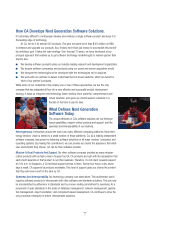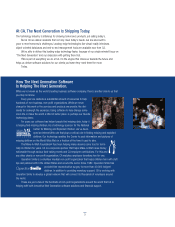Computer Associates 1997 Annual Report Download - page 16
Download and view the complete annual report
Please find page 16 of the 1997 Computer Associates annual report below. You can navigate through the pages in the report by either clicking on the pages listed below, or by using the keyword search tool below to find specific information within the annual report.
Results of Operations
This Annual Report contains certain forward-looking statements
and information relating to the Company that are based on the
beliefs and assumptions made by the Company’s management as
well as information currently available to management. When
used in this document, the words “anticipate,” “believe,” “esti-
mate,” and “expect” and similar expressions, are intended to
identify forward-looking statements. Such statements reflect the
current views of the Company with respect to future events and
are subject to certain risks, uncertainties and assumptions.
Should one or more of these risks or uncertainties materialize, or
should underlying assumptions prove incorrect, actual results may
vary materially from those described herein as anticipated,
believed, estimated or expected. The Company does not intend to
update these forward-looking statements.
Fiscal Year 1997
Total revenue for fiscal year 1997 was $4.0 billion, an increase
of 15% over the $3.5 billion recorded in fiscal year 1996. This
increase reflects the expanded demand for the Company’s prod-
ucts, particularly its Unicenter®family. The Cheyenne division’s
desktop and local area network products acquired in November
1996 contributed marginally to the increase. Revenue in North
America increased 40% for fiscal year 1997 due to strong accep-
tance of the Company’s client/server software solutions and the
ongoing increases in client computing capacity needs (as mea-
sured in MIPS). International revenue decreased 9% in fiscal year
1997 compared with fiscal year 1996. This was caused by a
combination of operational difficulties in refocusing the European
sales and marketing resources from mainframe to client/server
sales opportunities, exacerbated by economic conditions including
a weakening of the local currencies against the U.S. Dollar.
Maintenance revenue increased 2%, or $11 million in fiscal year
1997. This increase is due in part to the addition of a full year of
Legent maintenance revenue, partially offset by the ongoing trend
of site consolidations, and escalating client/server revenue which
generate lower maintenance revenue. Foreign exchange rate
movements negatively affected total revenue in fiscal year 1997
by approximately $43 million or slightly more than 1%. Price
changes did not have a material impact in either year.
Selling, marketing and administrative expenses for
fiscal year 1997 decreased to 36% of revenue from 39% in
fiscal year 1996. This reduction is a function of the continued
corporate-wide effort to reduce fixed and administrative costs as
well as operating efficiencies realized from integration of the
Cheyenne and Legent acquisitions. In fiscal year 1997, new prod-
uct research and development expenditures increased $33
million, or 12%. The continued emphasis on adapting products
for client/server environments and the addition of Cheyenne
development personnel were largely responsible for this increase.
Commissions and royalties were approximately 5% of total rev-
enue for both fiscal year 1997 and 1996. Depreciation and amor-
tization expense increased $20 million, or 5% in fiscal year 1997
over fiscal year 1996. This rise is largely the result of an addi-
tional $31 million associated with the Cheyenne acquisition par-
tially offset by decreased amortization from previous acquisitions.
For fiscal year 1997 net interest expense was $102 million, an
increase of $31 million over fiscal year 1996. The increase is
attributable to the higher debt levels associated with borrowings
used to finance the Cheyenne acquisition.
The charge of $598 million in fiscal year 1997 is a
write-off of purchased research and development technology that
had not reached the working model stage and has no alternative
future use. Fiscal year 1997 had a pre-tax profit of $932 million
compared to the pre-tax loss of $100 million in fiscal year 1996.
The pre-tax amounts for both fiscal years 1997 and 1996 include
research and development charges relating to the acquisitions
of Cheyenne and Legent of $598 million and $1,303 million,
respectively. Excluding these charges, pre-tax income for fiscal
year 1997 was $1,530 million compared to $1,203 million in
fiscal year 1996, an increase of $327 million, or 27%. The
Company has changed its accounting in fiscal year 1997 for
deferred taxes on purchased research and development. See Note
1 to Notes to Consolidated Financial Statements. The consolidated
effective tax rate, excluding the research and development
charges for fiscal year 1997 was 37% versus 37.5% in fiscal
year 1996. Including the aforementioned purchased research and
development charge, net income for fiscal year 1997 was $366
million compared to a net loss of $56 million for fiscal year 1996.
Management’s Discussion and Analysis
14
























